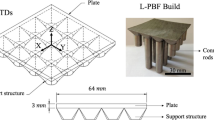Abstract
The surface of continuously cast slabs is characterized by the presence of oscillation marks. Direct linkage of the continuous casting process and hot rolling process requires that cast slabs should be free of surface defects. In the present work, a mechanical model has been developed for the prediction of the depth of oscillation marks of the depression type. It is based on the beam bending theory and on viscoplastic material behavior. The downward movement of the strand is taken correctly into account, which has not been done in previous models. Auxiliary parts of the model are the models for the determination of the temperatre field and of the fluid flow and pressure in the meniscus region and in the gap between strand and mold. The deflection of the shell is computed as a function of time and distance from the shell tip. The retained deflection, which corresponds to the depth of oscillation marks observed on the slab surface, is determined for different values of stroke, frequency, and casting velocity. The theoretical data are compared with the measured data as available in the literature.
Similar content being viewed by others
References
E. Takeuchi and J.K. Brimacombe: Metall. Trans. B, 1984, vol. 15B, pp. 493–509.
T. Emi, H. Nakato, Y. Iida, K. Emoto, R. Tachibana, T. Imai, and H. Bada: National Open Hearth and Basic Oxygen Steel Conf. Proc., 1978, vol. 61, pp. 350–61.
H. Tomono: Thèse No. 330, École Polytechnique Fédérale de Lausanne, Lausanne, 1979.
D.R. Bland: IMA J. Appl. Mathematics, 1984, vol. 32 pp. 89–112.
K. Schwerdtfeger, K.H. Tacke, and K. Minami: EC Project No. 7210-CA/1313/311/810 Reports 1 to 5 and Final Report EUR 9560 / I+II EN, 1985.
H. Nakato, T. Nozaki, Y. Habu, H. Oka, T. Ueda, Y. Kitano, and T. Koshikawa: Steelmaking Conf. Proc., 1985, vol. 68, pp. 361–65.
S. Takeuchi, Y. Miki, S. Itoyama, K. Kobayashi, K. Sorimachi, and T. Sakuraya: Steelmaking Conf. Proc., 1991, pp. 73–77.
H. Steinrück, C. Rudischer, and W. Schneider: Nonlinear Analysis, Theory, Methods & Applications, Proc. 2nd World Congr. of Nonlinear Analysis, Elsevier Science Ltd., New York, NY, 1997, vol. 30 (8), pp. 4915–25.
H. Steinrück, C. Rudischer, and W. Schneider: in Modeling of Casting, Welding and Advanced Solidification Processes VIII, B.G. Thomas and C. Beckermann, eds., TMS, Warrendale, PA, 1998, pp. 639–46.
J.R. King, A.A. Lacey, C.P. Please, P. Wilmott, and A. Zoryk: Math. Eng. Ind., 1993, vol. 4 (2), pp. 91–106.
T. Suzuki, K.H. Tacke, K. Wünnenberg, and K. Schwerdtfeger: Iron-making and Steelmaking, 1988, vol. 15, pp. 90–100.
T. Tanaka: CAMP-ISIJ, 1989, vol. 2, p. 1263.
H. Sha, R. Diedrichs, and K. Schwerdtfeger: Metall. Mater. Trans. B, 1996, vol. 27B, pp. 305–14.
R.H. Weber and R. Gans: Repertorium der Physik, B.G. Teubner-Verlag, Leipzig, 1916.
K. Harste and K. Schwerdtfeger: Mater. Sci. Technol. 1996, vol. 12, pp. 378–84.
O. Reynolds: Phil. Trans. R. Soc. London, 1886, vol. 177, pp. 157–234.
K. Schwerdtfeger: Advanced Physical Chemistry for Process Metallurgy, Academic Press Ltd., 1997, pp. 381–419.
K.H. Spitzer, K. Harste, B. Weber, P. Monhein, and K. Schwerdtfeger: Iron Steel Inst. Jpn. Int., 1992, vol. 32 (7), pp. 848–56.
H. Takeuchi, S. Matsumura, R. Hidaka, Y. Nagano, and Y. Suzuki: Tetsu-to-Hagané, 1983, vol. 69, pp. 248–53.
S. Itoyama: Ph. D. Dissertation, Tohoku University, Sendai, 1997.
E. Schürmann, L. Fiege, H.P. Kaiser, and T. Klages: Stahl Eisen, 1986, vol. 106, pp. 1196–1201.
A.W. Cramb and F.J. Mannion: Steelmaking Conf. Proc., 1985, vol. 68, pp. 349–59.
B.G. Thomas, D. Lui, and B. Ho: in Sensors and Modeling in Materials Processing: Techniques and Applications, S. Viswanathan, R.G. Reddy, and J.C. Malas, eds., TMS, Warrendale, PA, 1997, pp. 117–42.
Author information
Authors and Affiliations
Rights and permissions
About this article
Cite this article
Schwerdtfeger, K., Sha, H. Depth of oscillation marks forming in continuous casting of steel. Metall Mater Trans B 31, 813–826 (2000). https://doi.org/10.1007/s11663-000-0118-8
Received:
Issue Date:
DOI: https://doi.org/10.1007/s11663-000-0118-8




